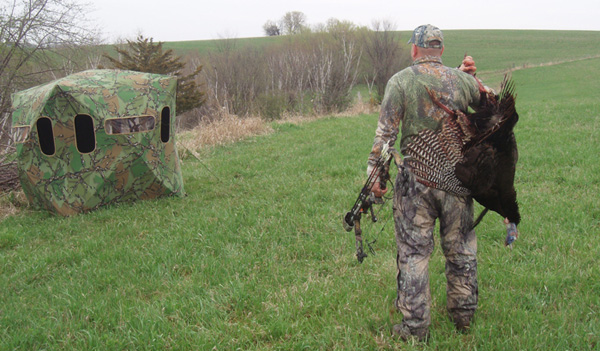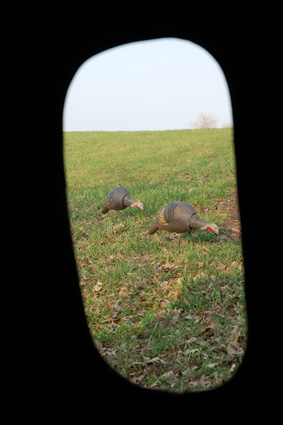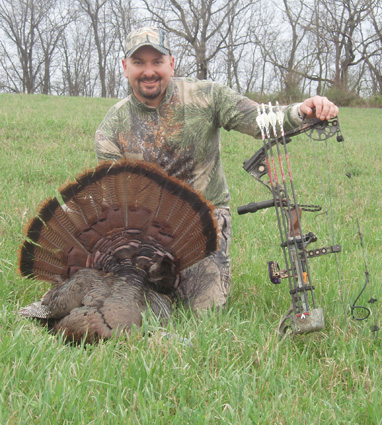It wasn’t until late morning that the warming rays of the early May sun managed to burn through what had been a drizzly, damp daybreak, and at least one tom turkey took notice. As they often do, the piercing gobble snapped me out of a trance that had begun some hours before.
By the time 11 a.m. rolled around my routine had become almost machine-like: Make a short string of hen yelps with a box call, wait five minutes, fire off a string of yelps with a diaphragm. Every now and then, on the advice of a friend, I’d double up on the calls — using them simultaneously — and it was during this excited “two-for-one” exchange that Mr. Gobbler spoke up.
When the second gobble came, much closer this time, I knew I was in business. Whether it was the invigorating sun or my unorthodox calling that drew him out of his shell I’ll never know. But I do know that tom came on a dead run for my decoy setup, and I laid him to rest there, barely 10 yards away, a few scant inches from my trusty fake jake the incoming gobbler had stopped to confront.
Bowhunting for turkeys can be almost too easy at times, but mostly it’s an intricate game of cat and mouse that requires some very specialized tactics.

South Dakota Turkey Hunting Fun
“You’re just a lot more conscious of where you set up when you’re bowhunting for turkeys.” says Dave Keiser, owner of Double K Guide Service in south-central South Dakota, near the Missouri River. “You’re looking for that 20 yards-and-under shot, and that often means looking at spots that will funnel turkeys, such as creek bottoms, shelter belts, fencelines. It just makes it easier to predict their travel patterns.”
Keiser knows of what he speaks; his clients regularly bag several dozen of the birds each spring, with a success rate that hovers at 90 percent. Leasing prime land has been one key, but another is the silent nature of bowhunting.
“There’s just less disturbance. I can go in and hunt the same flock of turkeys 10 days in a row with bowhunters, and take several gobblers, and you can’t do that with shotguns — you’d chase the turkeys off. (I lease) a lot of places where (the landowners) won’t even let me shotgun hunt at all. They want me to harvest some of the birds, but they don’t want them run off.”
 Keiser’s approach starts with regular scouting, pinpointing areas where turkey concentrations are high. Talking with landowners helps, as does a few sessions spent glassing open territory with quality binos.
Keiser’s approach starts with regular scouting, pinpointing areas where turkey concentrations are high. Talking with landowners helps, as does a few sessions spent glassing open territory with quality binos.
Equipment is also key; Keiser depends almost exclusively on Double Bull blinds, after experimenting with some other models found to be inferior.
“The greatest thing with the blind, is you can get away with so much movement. We use Double Bull blinds because there is no wind flap. They’re nice and tight. We get a lot of wind out here, and nothing scares a turkey faster than a blind that moves.”
Keiser also recommends mechanical broadheads for their proven effectiveness — his favorite heads are made by Rocket Aeroheads — and he is especially fond of turkey decoys that depict a jake mating with a hen. A string-operated setup allows the user to impart turkey-attracting movement that seems to draw big gobblers in consistently.
Calling remains sort of an enigma for Keiser; he knows it works but he also knows there is no one correct way to go about it.
“I call a lot myself, and a couple of my guides call very sparingly, and our success is probably the same. Usually, it doesn’t take a lot. I like a nice box call; I use the basic hen yelp, with some cutting. Nothing too technical.”
Get Aggressive With Turkey Hunting Blinds
When it comes to using blinds, few are more serious about the technique than Keith Beam and Brooks Johnson, both of whom have bow-bagged dozens of longbeards from blinds. Of course, the duo recommends starting with a quality blind, but often, they say, users don’t get aggressive enough.
“On average, we’ll probably move [in] on a bird five or six times; most guys don’t move that much,” says Johnson. “But to move effectively, you really have to know the lay of the land, you have to be familiar with your hunting grounds. It’ll help you know when and when not to move.”
As an example, Beam said, oftentimes you can effectively hunt a known strutting zone all day long (regulations permitting), or cut off a gobbler on his way to one. Strutting zones are areas where gobblers will spit and drum and otherwise display to attract potential mates — typically an area that offers good visibility to the approaching hens. Signs of a strutting zone are scratch marks in the dirt left by gobbler wing tips, loose feathers and J-shaped gobbler scat.
 “In our hunting, we’ve found that, day after day, year after year, gobblers have their favorite places to strut for the hens,” Beam said.“We’ve become more proficient the more we hunt the same spots, because we know where they’re going.”
“In our hunting, we’ve found that, day after day, year after year, gobblers have their favorite places to strut for the hens,” Beam said.“We’ve become more proficient the more we hunt the same spots, because we know where they’re going.”
Staying put has its advantages too, the duo say — it’s all about what you’re trying to accomplish.
“You have a better chance of killing a bird — any bird — by staying in one spot,” Johnson says. “But you have a much better chance of killing a specific bird by knowing the lay of the land.”
The duo also has noted a unique travel pattern that seems to hold true wherever turkeys live.
“We’ve noticed that turkeys like to go to green fields in the morning, be it winter wheat, low alfalfa — anything that’s green, growing and fresh — while they like to travel to the dead stuff in the afternoon, especially old, cut cornfields, or soybeans,” Johnson said. “Maybe it’s because they can find more bugs in the dead stuff, or it may be that they wait for muddy fields to dry out in the afternoon.”
Blind placement is another key element many find confusing, Beam says.
“Contrary to what seems to be popular belief, a blind does not need to be backed up to something to work. You want to have clean shooting opportunities all around you. A lot of times, gobblers want to circle around you, so the more open choice, often, is the best. We set up all the time in fields where the blind sticks out like a sore thumb, but the turkeys don’t mind a bit.”
A Blind With a View
Of course, the one downside to bowhunting from a blind is you're visibility is limited, right? Wrong. Recent innovations in blind-building technology has resulted in pop-up blinds such as the Primos Double Bull SurroundView, which allows you to see out (360 degrees with some models) and yet the turkeys can't see in. As Bob Robb said in an earlier Bowhunting World article, these new blinds are a game changer. Check out the photo below for a look at what you see from inside a SurroundView blind. From the outside, however, the turkey simply sees a standard camo ground blind, which they ignore almost every time.







